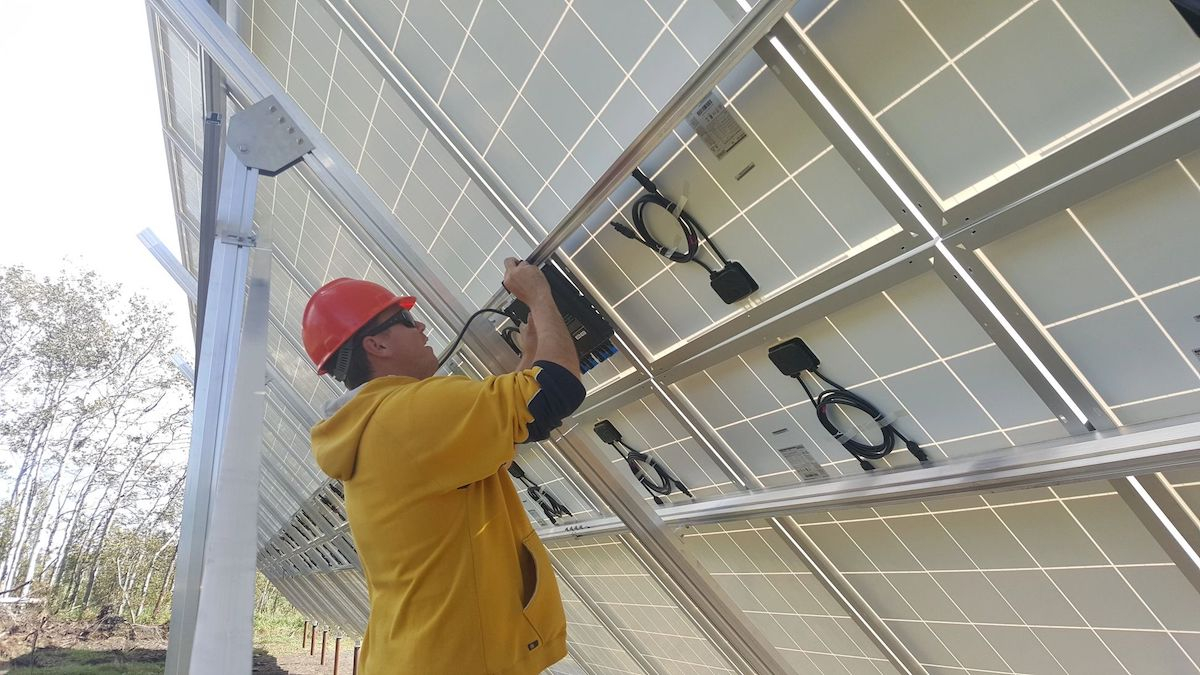- In Canada's sunniest province, Saskatoon is hoping to harness solar energy in its transition away from fossil fuels — by 2036, all new homes in the city will be required to maximize their solar panel coverage.
- The average two-person household in Saskatchewan uses about 5,200 kilowatt-hours of electricity per year, according to SaskPower. An average residential solar panel setup in Saskatoon could produce approximately 1,350 kWh per year.
- Installing solar panels may be expensive, but it pays off: SaskPower's net-metering program allows Saskatoon residents with solar panels to sell power back to the utility and save on their electric bills.
In Saskatchewan, signs of the province's reliance on resource extraction dot the landscape, from oil derricks standing in flat southern Prairie fields to mines carved out of the forests in the north.
Now its biggest city is working to change the vista, at least within city limits. By 2036, all new homes in Saskatoon will be required to maximize their solar panel coverage. The hope is that someday in the not so distant future, the glint from blue solar panel covered rooftops will dominate the scenery along banks of the South Saskatchewan River.
In a province where more than 80 per cent of the province’s electricity is still produced from fossil fuels, Saskatoon is trying to shift as much electricity production to renewable energy as possible. The city's goals are laid out in its Climate Action Plan which aims to reduce CO2 emissions by more than 54 million tonnes by 2050, says Jeanna South, the city's sustainability director.


Saskatchewan is aiming to bring down greenhouse gas emissions by 16% from 2018 levels.

Provincewide, Saskatchewan is aiming to bring down greenhouse gas emissions by 16 per cent from 2018 levels. In particular, the province highlights efforts to reduce emissions associated with agriculture, drive down energy consumption in government-owned buildings and shift to renewable energy sources. There are huge challenges, however — 30 per cent of the province’s electricity still relies on coal. Sask Power hopes to reduce its own greenhouse gas emissions by at least 50 per cent from 2005 levels by 2030.
Saskatoon’s plans tie into the provincial renewable strategy. Solar generation capacity has already risen tenfold from 2014 to 2020, as solar panels are installed on residential, institutional, commercial and industrial buildings. And while there is a long wait before they become mandatory in new residential builds, South says the city is working hard to help homeowners pursue other green options in the meantime.
One recently passed measure is the Home Energy Loan program, which allows homeowners to access low-interest loans to install energy efficiency retrofits or make environmentally sustainable improvements.

The sunshine province

Saskatoon is uniquely well-positioned to harness solar power. Saskatchewan is the sunniest province in Canada, and Saskatoon receives an average of 2,389 hours of sunlight per year. According to South, the average residential solar panel setup in Saskatoon could produce approximately 1,350 kilowatt-hours of electricity per year. As of 2016, according to SaskPower, the average residential energy consumption for a two-person household in Saskatchewan was just over 5,200 kilowatt-hours per year.
This advantageous geographic location was one factor that inspired Saskatoon homeowner Luc Bezaire to install solar panels on his roof nearly two years ago. Even though the initial cost was high, he knew eventually it would pay off in savings on his power bill while helping improve the environment.

There’s a shift in energy coming, and it’s not about throwing up your hands and acting like you can’t do anything. Every problem has a solution.
Luc Bezaire, Saskatoon homeowner
“We’re living in a world that’s looking at a transition — and that’s whether people want it or not,” he said. “There’s a shift in energy coming, and it’s not about throwing up your hands and acting like you can’t do anything. Every problem has a solution.”
A 2018 report by the Canadian Centre for Policy Alternatives found fewer than 20 per cent of Saskatchewan residents supported an immediate transition away from fossil fuels. However, over 60 per cent of those surveyed wanted the government to invest in wind and solar energy. A mere 3.7 per cent actively opposed investing in solar.
Since installing solar panels, Bezaire says his yearly power bill has dropped from over $3,000 to less than $600. And he is looking forward to seeing more of his neighbours take similar steps.
“When you look down the road, it’s the way of the future,” he said. “I think it would go a long way towards offsetting future increases in power generation — if we can control the growth of coal-fired power plants or gas-fired power plants through solar production, that’s all to the good.”
Bezaire notes the high cost of solar panel installation, which is a daunting factor for many otherwise enthusiastic homeowners, has dropped significantly over the past decade. If this trend continues, he said, “future builders will be negligent in their planning if they don’t plan for solar.”
Shane Wiedman, CEO of the Saskatoon-based solar panel installation company Sundawg Solar, agrees.
Since he started it four years ago, it has become more efficient every year, he said. “The costs have come down; the efficiency of these things are just getting better and better all the time.”

Once you invest in solar, realistically, your price will never increase after that. You have a locked-in price that you pay for.
Shane Wiedman, CEO of Sundawg Solar
Wiedman says solar energy is “one of the best investments you can make” to reduce power charges. He believes the pending residential solar mandate will be a boon to his business and put more money in the pockets of his neighbours.
“It’s the old question: if you could have locked in your gas prices at 45 cents per litre 20 years ago, knowing they would never increase, you would have done that?” he asked. “Once you invest in solar, realistically, your price will never increase after that. You have a locked-in price that you pay for.
“Then, once you pay that off, everybody else’s price of power is going to continue to rise while yours is just going to stay exactly where it was.”
In the long term, the financial advantages can be dramatic. SaskPower, the Crown corporation operating as the principal electric utility in Saskatchewan, offers a net-metering program for homes generating solar energy. Any excess power provided back onto the grid is priced at about 7.5 cents per kilowatt-hour, about half of the 14 cents residential customers pay for the same amount of power. Factoring in these credits and an initial average cost of $21,500 to install solar panels on a residential house, SaskPower estimates homeowners can recoup their initial investment in 15 to 17 years.
Saskatoon homeowners who live within the city’s 1952 boundaries, and are served by Saskatoon Light & Power instead of SaskPower, can benefit from one-to-one net metering for any solar energy they generate and recoup their investment that much faster.
Requiring solar panels on Saskatoon roofs is not the largest component of the city’s Climate Action Plan. But by 2050, the city estimates this measure will save just over five million tonnes of CO2.
According to Jason Praski, the principal of Saskatoon firm Exa Energy Consulting, it’s a decision with very little downside.
“Of course it will help with the target of reducing our community’s greenhouse gas emissions,” he said. “It’s free real estate on rooftops, which is something other organizations have understood and agree that it’s a really good place for things like solar panels to be placed.
“The local economy gets a benefit. There’s a lot of reputable solar designers, installers, electricians, contractors, et cetera who will hopefully gain business and pay local taxes.”
Praski also sees another critical benefit to solar panels becoming the norm in Saskatchewan’s biggest city: increased energy literacy and acknowledgement of options beyond oil and gas.
“In Saskatchewan, we don’t necessarily see a lot of leadership in explaining to us where our electricity comes from and why we should be doing things like this,” he said. “So when a homeowner embarks on this project, I think there’s a lot of learning that comes with it — about using the sun for energy production, reducing greenhouse gas emissions, reducing your carbon footprint, the economic payoff and more.”







Comments
In a city, solar is also valuable for trees, gardens, and natural lighting. Where it is going to waste, it would be nice to see solar panels that double as roofing materials, but overall, I prefer panel fields nearby, and dense development to reduce transportation energy costs.
I recently researched solar for my house in Vancouver and found it to be well worth it until three things were realized: (i) BC Hydro will change its Net Metering program in 2024 to pay only 4 cents per kilowatt hour instead of today's 1:1 ratio -- credit valued equal with the current 9.41 c / kWh customers pay; (ii) the cost of switching at least two of our three gas appliances to electricity (gas does the heavy lifting in our house at present; an electric induction stove and electric 'on demand' hot water unit were considered, and a replacement heat pump for our relatively new high-efficiency gas furnace would have been closer to the lifespan warranty of the furnace) in order to carve out a bigger hole in the Hydro bill with solar credits; and (iii) my parter's inability to buy in to the concept after (ii).
The Net Metering policy change has angered a lot of people in BC who have already installed solar panels, as well as contractors, especially those with a decade of experience. The Tsilhqot’in Nation was also taken aback by BC Hydro when Hydro refused to pay even the break-even kWh cost to what would have been the largest solar array project in the province, and one of the largest on the continent.
BC Hydro has taken on some controversial and massively expensive projects, namely the $15B Site C dam and a promise by both the conservative BC Liberals (I know, it's confusing) and the NDP to sweeten the LNG pot by negotiating massive amounts of power delivery at extremely favourable rates (read: subsidized) to the private gas consortium for liquefaction that will never be enjoyed by ordinary ratepayers who are otherwise defined as the owners of the public utility.
Indeed, it's behaving like the monopoly it is.
As the result of these huge pots of accumulating debt, rates are going to climb. Meanwhile, the glaciers that feed the reservoirs are melting at increasingly fast rates. One of the latest studies predicts that the glaciers in the Columbia River basin that supply water for three dams in BC and the largest in the US downstream, will be mostly gone in 50 years. Doesn't BC Hydro have a realistic plan for climate change?
In this context, I think many customers will do the math over the years and decide to go completely off-grid. We might even see entire developments and communities produce their own power for their own local grids, essentially telling Hydro to take a hike. Solar panels, wind turbines and home-scale batteries are already on the ground and are ramping up. Industrial-scale batteries using cheap materials like iron, calcium, zinc, antimony and others are now leaving the lab and becoming commercialized.
A centralized monopoly and decentralized renewables can work together as a powerful dynamic to adapt to climate change, eliminate emissions, keep rates reasonable and to export for profit. We just have to get the politicians out of the way, or at least keep them from making more bad decisions.
Solar panels on residences may be part of the solution to get to net zero but as the article indicates an average array would produce only 20% of average residence usage. True, the cost of the panels is coming down but a significant portion of the cost of a residential array is now the cost of installation (i.e. labour), and that is likely to come down only slowly (with experience and scale), but may also increase (labour inflation) over time. We really need to look at industrial scale solar arrays, which is a communal versus individual homeowner approach to get to net zero for residential electricity.
Not sure where your number originates. It's possible to generate 40%-75% of your annual consumption with solar PV, even in Vancouver which has more sunshine hours than Berlin -- a solar powerhouse -- at similar latitudes. Vancouver's rainy winters are more than made up by seven months of sun in summer and the shoulder seasons. Saskatoon and other Prairie cities are way sunnier, notably in winter when solar PV panels are running at optimum efficiency in the cold.
Applied to my own house with exposed east and south roofs, 20 PV panels generating 320 watts in full summer sun will result in around 56 kilowatt hours a day within six weeks either side of summer solstice. That's triple the highest consumption day in July, and 3.6 times the average. BC Hydro currently credits solar at 1:1 under its Net Metering program, so in essence a net 1.5 days of credit are banked for winter use for every summer day of solar, factoring the higher power use in the cold season.
Considering that the best panels produce power in low light conditions, you're still offsetting power consumption directly with solar in the dead of a Vancouver winter. Modern houses designed to conserve energy (ours is a 110-year old Edwardian...) will require less energy overall, and the solar production could exceed 80% of all energy in Saskatoon with more than 24 panels.
Installing solar PV is affordable with Net Metering because you avoid the high cost of batteries, but that requires the long-term co-operation of the utility.
My main point is that a communal solution (i.e. industrial scale solar arrays feeding renewable electricity to all residences) will be much less expensive than each individual residence installing a rooftop array. A huge amount of investment is going to be required to decarbonize all segments of society and the economy so we need to focus on the most cost effective solutions.
According to the article, the payback period in Saskatoon for more than a dozen panels is under eight years. The situation in all sunny provinces is similar. With net metering you won't need to spend $10+K on lithium batteries; essentially, the utility is your storage battery. That works out to 17 years of profit and lower emissions. With this kind of advantage, cities can kiss natural gas goodbye in all new residential and commercial development, and replace it in existing neighbourhoods.
While large scale mass-produced renewable energy projects are a valuable part of any climate strategy, namely in delivering cheap zero-emission electricity, that advantage does not end at one's front door. In fact, 100,000 solar roofs sending power to the grid is a decentralized, but nonetheless large scale project. Vast quantities of clean power can still be directed to industry. Rooftop solar at scale also results in less depreciation and maintenance on a utility's infrastructure and adds years to the period between new generation projects.
Would that BC Hydro take that into account before the planned decimation of its Net Metering program in 2024 while the debt piles up on the controversial and glitch-plagued Site C dam project.
The 17 years of profit was calculated by deducting the stated ~8-year payback time from the 25-year warranty of the panels, performance rating and labour. ION reality, the best panels last well over 30 years.
Thousands of rooftop solar PV systems are the very definition of a community solution. They will complement large-scale projects. Both are viable and necessary.